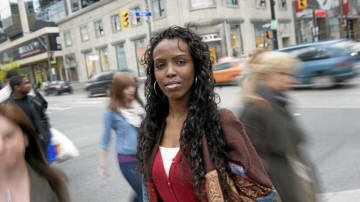Putting a fresh face on Toronto’s leadership
 When Jamilla Mohamud sat through her first city council meeting late last fall, she was stunned. Not by the length, the level of detail or the councillors’ aggressive banter, but by the people occupying seats in council chambers.
When Jamilla Mohamud sat through her first city council meeting late last fall, she was stunned. Not by the length, the level of detail or the councillors’ aggressive banter, but by the people occupying seats in council chambers.
Why weren’t there more women? Where were the Somali Canadians?
“It was very shocking,†she said. “In school, you’re taught that everyone’s equal. … So where’s the divide? In my area, it’s the women and the mothers who take the initiative and make things happen. On city council, it’s not really reflected that way.â€
Ms. Mohamud had never given city politics a second thought (“When I was younger, I was thinking more on the federal level,†she said) until her old employer, Africans in Partnership Against AIDS, forwarded an e-mail about the city’s Regional Champion Campaign, a program that aims to get young women involved in municipal politics.
“You see the results of your work directly. … I think it’s amazing,†she said.
So much so that she’s giving up her Tuesday evening to learn about how to join the city’s agencies, boards and commissions – the myriad bodies that help make decisions on everything from police services to health bylaws and the Toronto Zoo.
“[My friends] were like, ‘What?’†she said.
But the 24-year-old biology graduate sees this as her ticket into city politics and, who knows, maybe the mayor’s seat some day.
Toronto often boasts it’s the most diverse city in the world. But you might not know it from looking at city council, or many of the city’s arm’s-length agencies, boards and commissions.
These all remain older, more male and more white than Toronto’s broader population – something the city has spent the past four years making a concerted effort to change.
Some of those efforts are paying off: Since the city put in place a formal public appointments policy in 2006 that focused on diversifying the public service, those bodies have better reflected the city.
Women now make up 44 per cent of the city’s boards and commissions, as opposed to 33 per cent six years ago. But Southeast Asians, who comprise 5 per cent of Toronto’s population, make up only 1 per cent of board, agency and commission membership. Aboriginals? Zero per cent.
Tuesday’s how-to seminar on the public appointment process aims to increase that.
The city’s getting better, says Cathy Winter, manager of the Maytree Foundation’s DiverseCity onBoard program. It’s becoming more transparent, and more aware of the need to reach out to those who aren’t normally municipal politics wonks.
“They’ve come a long way,†she said. “And they’re measuring it, which they weren’t before. They can see where they have to improve.â€
Councillor Janet Davis chalks it up to concerted efforts at three stages: outreach, shortlisting and selection of successful candidates. She said rules dictating exactly what role councillors can play in the selection process help ensure that the people chosen aren’t just friends or acquaintances of elected officials.
Alok Mukherjee, the police board’s first South Asian chair and a long-time advocate of diversity in Toronto’s leadership, said he’s delighted the city has decided to make this a priority. Toronto’s political institutions are making great strides when it comes to inclusion, he said, but “there’s still a significant distance to travel.â€
The applicant pool is there, he insisted, but the city needs to look more closely at what qualities it’s screening for, and whom that leaves out.
“I think there’s a general recognition that we live in a vastly different city than what it was like 20 or 30 years ago,†he said. “So I think there’s a general sensitivity. … The question is whether the criteria that are used are helping to translate that sensitivity into concrete results.â€
Creating a corporate population that reflects Toronto itself means the city has to change the way it thinks, acts and recruits, says Keiko Nakamura, head of the Toronto Community Housing Corp. “You want a diverse public service to get a better set of results,†she said. “It creates better public policy … when you have a leadership and workers who reflect the desires and needs of that public.â€
Comments
comments
 Calendar
Calendar






































